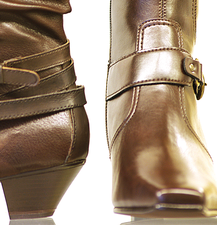Improving boot performance with Bootchart
Shining Boot

© Markus Langer, Fotolia
Bootchart analyzes the boot process and tells you where the system is wasting time.
In this article, I explain how to deploy Bootchart to investigate the boot process and discover where system optimization can be applied to maximum effect.
One of the gripes about Linux is the amount of time it takes to boot. When you switch on a Linux-based mobile phone, you don't want to wait half an hour before you can start to use it. Linux desktop users aren't infinitely patient either, and developers have introduced various tools over the years to tackle the issue of boot time. If you make the effort to analyze the boot process, the results can be remarkable. The Moblin2 distribution boots from a solid-state drive in just five seconds [1], and the boot time for the usual Debian on an Asus Eee PC 901 can be reduced to a fast 14 seconds.
A handy tool called Bootchart [2] investigates the boot performance of a Linux computer. The application painstakingly logs the boot times for individual services and processes, then it converts the data into a lengthy Gantt diagram and outputs it in EPS, PNG, or SVG format. The diagram serves as a guide for directing your performance-tuning efforts.
[...]
Buy Linux Magazine
Subscribe to our Linux Newsletters
Find Linux and Open Source Jobs
Subscribe to our ADMIN Newsletters
Support Our Work
Linux Magazine content is made possible with support from readers like you. Please consider contributing when you’ve found an article to be beneficial.

News
-
Linux Mint 22.2 Beta Available for Testing
Some interesting new additions and improvements are coming to Linux Mint. Check out the Linux Mint 22.2 Beta to give it a test run.
-
Debian 13.0 Officially Released
After two years of development, the latest iteration of Debian is now available with plenty of under-the-hood improvements.
-
Upcoming Changes for MXLinux
MXLinux 25 has plenty in store to please all types of users.
-
A New Linux AI Assistant in Town
Newelle, a Linux AI assistant, works with different LLMs and includes document parsing and profiles.
-
Linux Kernel 6.16 Released with Minor Fixes
The latest Linux kernel doesn't really include any big-ticket features, just a lot of lines of code.
-
EU Sovereign Tech Fund Gains Traction
OpenForum Europe recently released a report regarding a sovereign tech fund with backing from several significant entities.
-
FreeBSD Promises a Full Desktop Installer
FreeBSD has lacked an option to include a full desktop environment during installation.
-
Linux Hits an Important Milestone
If you pay attention to the news in the Linux-sphere, you've probably heard that the open source operating system recently crashed through a ceiling no one thought possible.
-
Plasma Bigscreen Returns
A developer discovered that the Plasma Bigscreen feature had been sitting untouched, so he decided to do something about it.
-
CachyOS Now Lets Users Choose Their Shell
Imagine getting the opportunity to select which shell you want during the installation of your favorite Linux distribution. That's now a thing.

